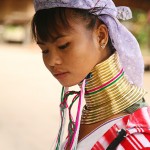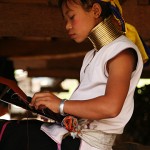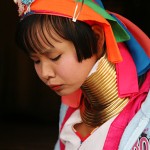And in this Neck of the Woods…
In northwestern Thailand and across into neighboring Myanmar, we find the small but visually striking Kayan tribe (also known as Padaung or Long-Neck Karen tribe).
Their claim to fame? Coils of brass around their necks that depress their collar bone down, compress their rib cage, and give them a giraffe-like long-necked look. Theories differ on why this custom started, from beautification to protection against tiger bites to religious, but whatever the initial reason, the tradition stayed.
A very small tribe and long-persecuted, about 1,500 Kayan now live in a refugee camp along the Thai-Burmese border, their livelihood (and likely their cultural survival) largely dependent on tourism. That has both pros and cons, certainly, but does not change their unique place in southeast Asia’s rich cultural history.






 Click to subscribe via RSS feed
Click to subscribe via RSS feed

It is surprising that this tradition has survived to this very recent generation. In several of the other cultures you have visited, the younger generations often appeared to be much less traditional than the older members of the communities. Also, why have they been persecuted?
For the Padaung in Thailand, the reason the tradition has continued to the younger generation is economic–these villages are almost entirely dependent on tourism for revenue. It may be that in certain parts of Myanmar this is not the case (the tribal villages I visited while in Myanmar, for instance, saw almost zero foreign visitors), but I’m not sure if this applies to the Padaung tribe.
Most hill tribes in the Golden Triangle have been persecuted, the hardship of being a small minority (and of being weaned off their livelihood of growing opium). It is, ironically, tourism that will go a long way to help them, albeit like the Padaung above eventually at the expense of a certain authenticity.